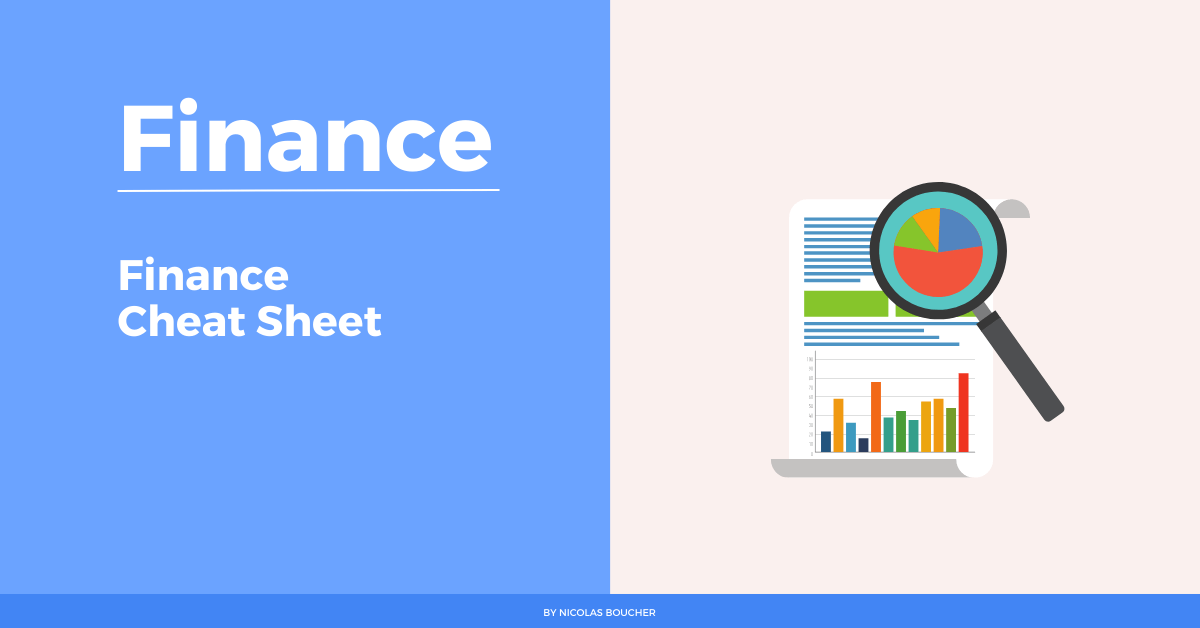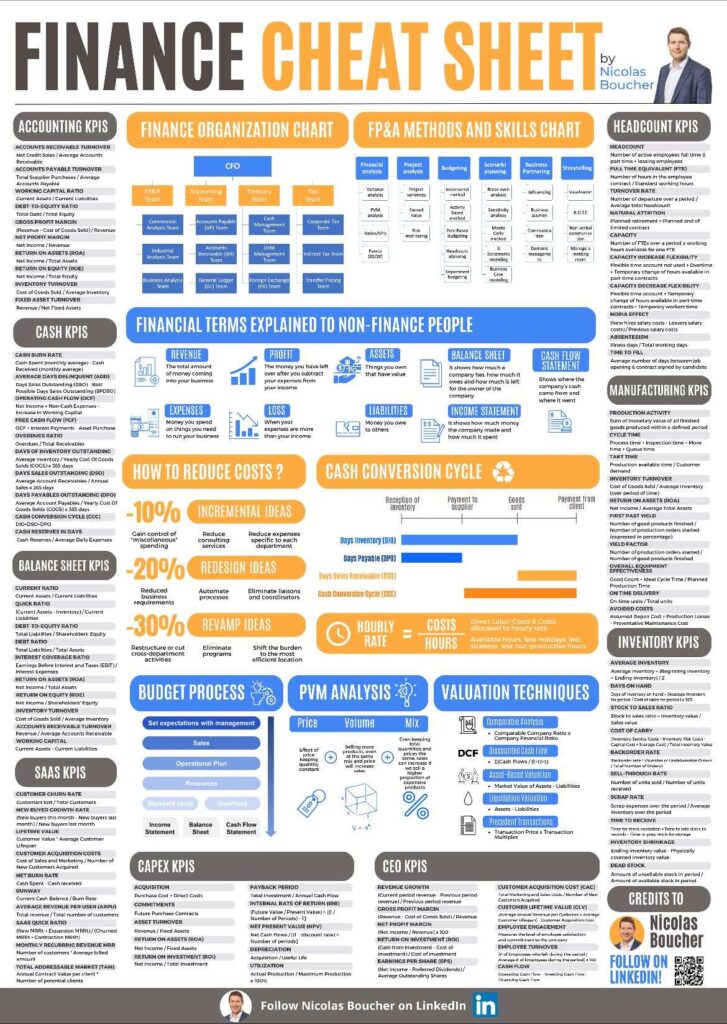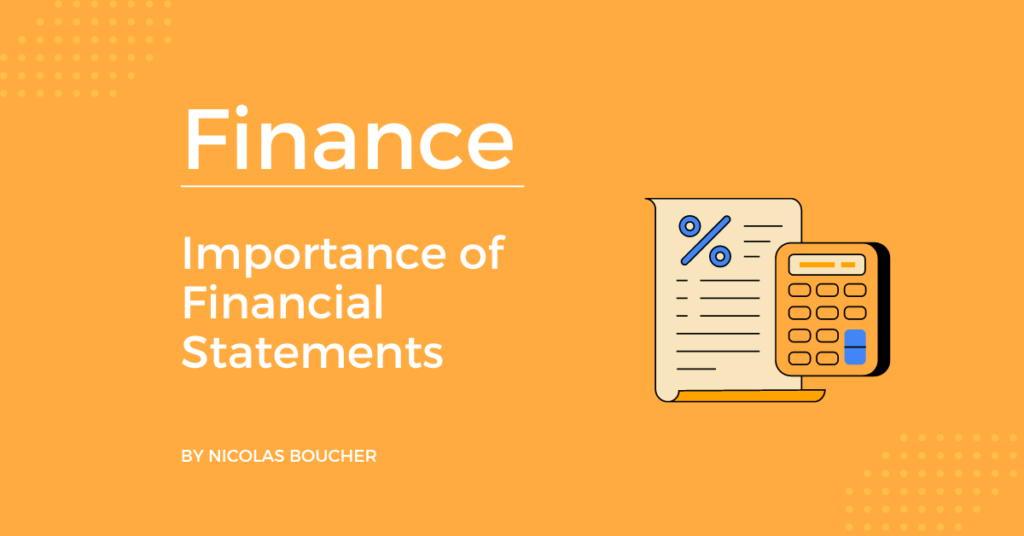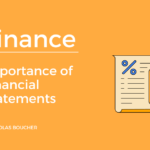Welcome to the world of finance, where mastering the art of it can lead to financial success and freedom. Whether you’re a beginner or looking to enhance your financial knowledge, having a handy finance cheat sheet can be your secret weapon.
In this blog post, we’ll explore how to navigate the intricacies of finance and empower yourself with essential tips and tools.
What’s Inside The Finance Cheat Sheet?
Here are the valuable insights you can find in the finance cheat sheet.
#1: Finance Organization Chart
This chart visually illustrates the structure and hierarchy within a finance department or organization.
It provides an overview of the different roles and responsibilities within the finance team, highlighting reporting lines and key positions.
#2: FP&A Methods and Skills Chart
This chart outlines the essential methods and skills required in financial planning and analysis (FP&A).
It covers areas such as financial forecasting, budgeting, variance analysis, financial modeling, data analysis, and presentation skills.
Furthermore, the chart serves as a quick reference for professionals in FP&A roles to enhance their competencies.
#3: Accounting KPIs
This section includes key performance indicators (KPIs) related to accounting.
It covers metrics such as accounts receivable turnover, accounts payable turnover, working capital ratio, debt-to-equity ratio, gross profit margin, net profit margin, return on assets (ROA), return on equity (ROE), inventory turnover, and fixed asset turnover.
Additionally, these KPIs help evaluate financial performance and efficiency.
#4: Headcount KPIs
This section focuses on key performance indicators related to workforce management.
Moreover, it includes metrics such as headcount, full-time equivalent (FTE), turnover rate, natural attrition, capacity, and capacity flexibility.
These KPIs provide insights into workforce planning, productivity, and efficiency.
#5: Cash KPIs
This section covers key performance indicators related to cash management.
It includes metrics such as cash burn rate, average days delinquent (ADD), operating cash flow (OCF), free cash flow (FCF), overdue ratio, days of inventory outstanding, and financial terms explained to non-finance people.
#6: Manufacturing KPIs
This section focuses on key performance indicators specific to the manufacturing industry.
It includes metrics such as production activity, cycle time, days sales outstanding (DSO), days payables outstanding (DPO), cash conversion cycle (CCC), and inventory turnover.
As a result, these KPIs help monitor and optimize manufacturing processes and inventory management.
#7: Balance Sheet KPIs
This section includes key performance indicators related to the balance sheet.
It covers metrics such as current ratio, quick ratio, debt-to-equity ratio, interest coverage ratio, return on assets (ROA), return on equity (ROE), inventory turnover, accounts receivable turnover, working capital, and more.
These KPIs provide insights into a company’s financial health and solvency.
#8: Inventory KPIs
This section focuses on key performance indicators specifically related to inventory management.
Here you can find metrics such as average inventory, days on hand, stock-to-sales ratio, cost of carry, backorder rate, sell-through rate, scrap rate, time to receive, and inventory shrinkage.
These KPIs help optimize inventory levels and improve supply chain efficiency.
#9: SAAS KPIs
This section covers key performance indicators relevant to Software-as-a-Service (SAAS) businesses.
It includes metrics such as customer churn rate, new buyer growth rate, lifetime value (LTV), average revenue per user (ARPU), monthly recurring revenue (MRR), total addressable market (TAM), and more.
Furthermore, these KPIs help measure the success and profitability of SAAS companies.
#10: CapEx KPIs
This section focuses on key performance indicators related to capital expenditures (CapEx).
It involves metrics such as acquisition costs, commitments, asset turnover, return on assets (ROA), return on investment (ROI), net present value (NPV), and more.
In addition, these KPIs help evaluate the financial viability and efficiency of capital investment projects.
#11: CEO KPIs
This section covers key performance indicators relevant to CEOs and executive leaders.
It includes metrics such as payback period, revenue growth, customer acquisition cost (CAC), earnings per share (EPS), utilization, employee engagement, and more.
These KPIs help assess the overall performance and strategic direction of a company.
#12: Financial Terms Explained to Non-Finance People
This section provides simplified explanations of important financial terms and concepts.
It helps non-finance individuals understand and interpret terms related to assets, revenue, profit, expenses, balance sheets, income statements, cash flow, and more.
#13: How to Reduce Costs
This section offers strategies and tips for cost reduction in various areas of business operations.
It explores incremental ideas, redesigns ideas, and revamps ideas to minimize expenses and improve efficiency.
#14: Cash Conversion Cycle
This section explains the concept of the cash conversion cycle (CCC) and its significance in managing working capital.
It covers the components of CCC and how optimizing it can positively impact cash flow and profitability.
#15: Budget Process
This section discusses the budgeting process and its importance in financial planning and control.
It outlines the steps involved in creating and managing budgets, ensuring financial stability, and effective resource allocation.
#16: PVM Analysis
This section introduces the Price-Volume-Mix (PVM) analysis technique used to evaluate the drivers of revenue growth.
It explains how analyzing price changes, volume changes, and product mix changes can help businesses make informed decisions and optimize revenue generation.
#17: Valuation Techniques
This section provides an overview of different valuation techniques used in finance, such as comparative analysis, discounted cash flow (DCF), asset-based valuation, the market value of assets minus liabilities, and precedent transactions.
Also, it highlights the importance of valuation in determining the worth of assets, businesses, and investment opportunities.
The Final Verdict – Grab The Finance Cheat Sheet
By mastering the art of finance with the comprehensive finance cheat sheet, you gain the tools and knowledge to make informed financial decisions.
Whether it’s analyzing key performance indicators, understanding financial statements, or optimizing costs and operations, this cheat sheet acts as your go-to resource.
With these valuable insights, you can navigate the world of finance with confidence and achieve your financial goals.
Don’t wait any longer grab it now!
Lastly, do you find the obstacles in your career you are facing frustrating? Then, you are in the right place! Start learning today and fulfill your potential with this unique finance course!
Key Takeaways
- The Finance Cheat Sheet provides essential tools and information to master the art of finance.
- It covers various accounting and financial key performance indicators (KPIs).
- The cheat sheet also includes insights on cash flow management, employee engagement, and customer acquisition costs.
- Understanding financial terms and utilizing the cheat sheet’s resources will empower you in making informed financial decisions.
- By applying the knowledge gained, you can enhance your financial acumen and work towards achieving your financial goals.












